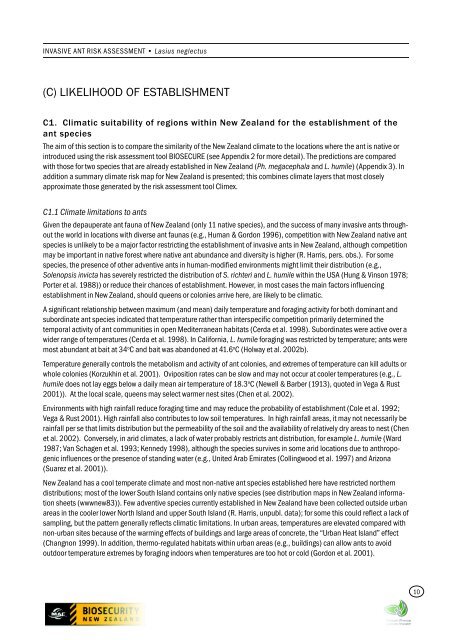Lasius neglectus (A) PEST INFORMATION - Biosecurity New Zealand
Lasius neglectus (A) PEST INFORMATION - Biosecurity New Zealand
Lasius neglectus (A) PEST INFORMATION - Biosecurity New Zealand
Create successful ePaper yourself
Turn your PDF publications into a flip-book with our unique Google optimized e-Paper software.
INVASIVE ANT RISK ASSESSMENT • <strong>Lasius</strong> <strong>neglectus</strong><br />
(C) LIKELIHOOD OF ESTABLISHMENT<br />
C1. Climatic suitability of regions within <strong>New</strong> <strong>Zealand</strong> for the establishment of the<br />
ant species<br />
The aim of this section is to compare the similarity of the <strong>New</strong> <strong>Zealand</strong> climate to the locations where the ant is native or<br />
introduced using the risk assessment tool BIOSECURE (see Appendix 2 for more detail). The predictions are compared<br />
with those for two species that are already established in <strong>New</strong> <strong>Zealand</strong> (Ph. megacephala and L. humile) (Appendix 3). In<br />
addition a summary climate risk map for <strong>New</strong> <strong>Zealand</strong> is presented; this combines climate layers that most closely<br />
approximate those generated by the risk assessment tool Climex.<br />
C1.1 Climate limitations to ants<br />
Given the depauperate ant fauna of <strong>New</strong> <strong>Zealand</strong> (only 11 native species), and the success of many invasive ants throughout<br />
the world in locations with diverse ant faunas (e.g., Human & Gordon 1996), competition with <strong>New</strong> <strong>Zealand</strong> native ant<br />
species is unlikely to be a major factor restricting the establishment of invasive ants in <strong>New</strong> <strong>Zealand</strong>, although competition<br />
may be important in native forest where native ant abundance and diversity is higher (R. Harris, pers. obs.). For some<br />
species, the presence of other adventive ants in human-modified environments might limit their distribution (e.g.,<br />
Solenopsis invicta has severely restricted the distribution of S. richteri and L. humile within the USA (Hung & Vinson 1978;<br />
Porter et al. 1988)) or reduce their chances of establishment. However, in most cases the main factors influencing<br />
establishment in <strong>New</strong> <strong>Zealand</strong>, should queens or colonies arrive here, are likely to be climatic.<br />
A significant relationship between maximum (and mean) daily temperature and foraging activity for both dominant and<br />
subordinate ant species indicated that temperature rather than interspecific competition primarily determined the<br />
temporal activity of ant communities in open Mediterranean habitats (Cerda et al. 1998). Subordinates were active over a<br />
wider range of temperatures (Cerda et al. 1998). In California, L. humile foraging was restricted by temperature; ants were<br />
most abundant at bait at 34 o C and bait was abandoned at 41.6 o C (Holway et al. 2002b).<br />
Temperature generally controls the metabolism and activity of ant colonies, and extremes of temperature can kill adults or<br />
whole colonies (Korzukhin et al. 2001). Oviposition rates can be slow and may not occur at cooler temperatures (e.g., L.<br />
humile does not lay eggs below a daily mean air temperature of 18.3 o C (<strong>New</strong>ell & Barber (1913), quoted in Vega & Rust<br />
2001)). At the local scale, queens may select warmer nest sites (Chen et al. 2002).<br />
Environments with high rainfall reduce foraging time and may reduce the probability of establishment (Cole et al. 1992;<br />
Vega & Rust 2001). High rainfall also contributes to low soil temperatures. In high rainfall areas, it may not necessarily be<br />
rainfall per se that limits distribution but the permeability of the soil and the availability of relatively dry areas to nest (Chen<br />
et al. 2002). Conversely, in arid climates, a lack of water probably restricts ant distribution, for example L. humile (Ward<br />
1987; Van Schagen et al. 1993; Kennedy 1998), although the species survives in some arid locations due to anthropogenic<br />
influences or the presence of standing water (e.g., United Arab Emirates (Collingwood et al. 1997) and Arizona<br />
(Suarez et al. 2001)).<br />
<strong>New</strong> <strong>Zealand</strong> has a cool temperate climate and most non-native ant species established here have restricted northern<br />
distributions; most of the lower South Island contains only native species (see distribution maps in <strong>New</strong> <strong>Zealand</strong> information<br />
sheets (wwwnew83)). Few adventive species currently established in <strong>New</strong> <strong>Zealand</strong> have been collected outside urban<br />
areas in the cooler lower North Island and upper South Island (R. Harris, unpubl. data); for some this could reflect a lack of<br />
sampling, but the pattern generally reflects climatic limitations. In urban areas, temperatures are elevated compared with<br />
non-urban sites because of the warming effects of buildings and large areas of concrete, the “Urban Heat Island” effect<br />
(Changnon 1999). In addition, thermo-regulated habitats within urban areas (e.g., buildings) can allow ants to avoid<br />
outdoor temperature extremes by foraging indoors when temperatures are too hot or cold (Gordon et al. 2001).<br />
10
















